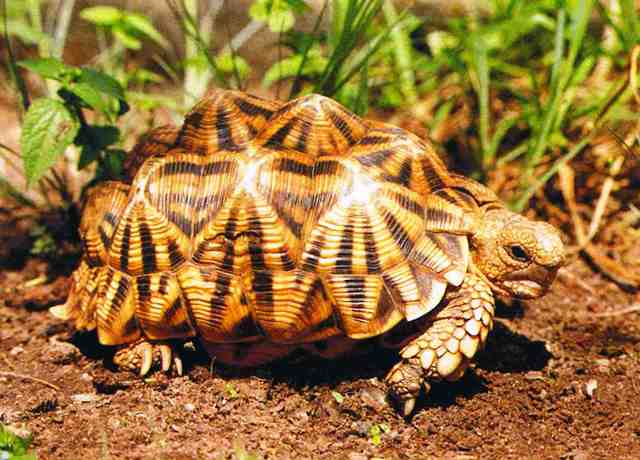Superregnum: Eukaryota
Regnum: Animalia
Subregnum: Eumetazoa
Cladus: Bilateria
Cladus: Nephrozoa
Superphylum: Deuterostomia
Phylum: Chordata
Subphylum: Vertebrata
Infraphylum: Gnathostomata
Superclassis: Tetrapoda
Cladus: Reptiliomorpha
Cladus: Amniota
Classis: Reptilia
Cladus: Eureptilia
Cladus: Romeriida
Subclassis: Diapsida
Cladus: Sauria
Cladus: Archelosauria
Division: Pan-Testudines
Division: Testudinata
Ordo: Testudines
Subordo: Cryptodira
Superfamilia: Testudinoidea
Familia: Testudinidae
Genus: Psammobates
Species: Psammobates oculifer
Name
Psammobates oculifer (Kuhl, 1820)
Type location: Republic of South Africa.
Synonyms
Testudo oculifera
Testudo semiserrata
Psammobates oculiferus
Vernacular names
čeština: Želva kalaharská
English: Serrated Tortoise
The serrated tortoise, Psammobates oculifer, German: Kalahari-Strahlenschildkröte, is a species of tortoise that occurs in the Kalahari desert regions of southern Africa. Also known as the Kalahari tent tortoise, it is one of three members of the genus, Psammobates.
Name
The common name internationally, serrated tortoise, stems from the characteristic, ray-like shell pattern and is shared by another tortoise species, Kinixys erosa. In southern Africa it is known by the unambiguous name of Kalahari tent tortoise, after its Kalahari habitat.[3]
Distribution
Psammobates tent tortoise species map - Southern Africa.png
The serrated tortoise is found in Southern Africa. Here it favours arid savanna and scrub desert vegetation types (e.g. Kalahari thornveld, bushveld and arid grassland). This area lies within the border regions of Botswana, Namibia, and the Republic of South Africa from extreme W Transvaal and the W Orange Free State northwestward across most of Botswana and central and eastern Namibia.
In this range, which roughly matches the extent of the Kalahari desert, its population is very sparse, and individuals are normally very rare and widely separated.[4]
Description
Kalahari Tent Tortoise (Psammobates oculifer) (6856968282).jpg
This species remains relatively small, with a shell length of 12–15 cm. While it shares much of its superficial outer appearance with its relatives in the genus Psammobates, it can be distinguished by its relatively low-domed shell which is strongly serrated along its margins at the front and back.
Each shell scute is coloured with a radiating star-pattern of black rays on a tan background. The species has buttock tubercles and the shell's nuchal scute is wide and sometimes divided. The males have a longer tail and taller, more conical scutes on the back as well as a concave belly. The female lays a clutch of 1 or 2 eggs in December.
Human use and conservation
The San used the shells of small animals to produce tobacco and perfume cases, a practice that is restricted today, due to nature conservation legislation to protect this declining species.
This tortoise species feeds on certain succulents and other Kalahari plant species, and its specific diet means that it does not usually survive in captivity and usually soon dies when removed from its natural habitat. It is nonetheless threatened by illegal collecting for the pet trade. [5]
References
JCVI.org (Retrieved Feb. 25, 2010).
Fritz Uwe; Peter Havaš (2007). "Checklist of Chelonians of the World" (PDF). Vertebrate Zoology. 57 (2): 289–290. ISSN 1864-5755. Archived from the original (PDF) on 2010-12-17. Retrieved 29 May 2012.
JCVI.org (Retrieved Feb. 26, 2010).
E.H.W. Baard: Cape Tortoises: Their identification and care. Cape Nature Conservation. 1994.
"Kalahari-Strahlenschildkröte - Trinken wie der Tok-Tokkie-Käfer". Stamps and Stories (in German). Gondwana Collection (57). 30 October 2012.
Dewsburycrafts with photo
GBIF.org
Auerbach,R.D. 1987. The Amphibians and Reptiles of Botswana. Mokwepa Consultants, Botswana, 295 pp.
Bauer, Aaron M.; Branch, William R. & Haacke, Wulf D. 1993. The herpetofauna of the Kamanjab area and adjacent Damaraland, Namibia. Madoqua (Windhoek), 18 (2): 117–145.
Duméril, A. M.C., G. BIBRON & A. DUMÉRIL 1854. Erpétologie générale ou Histoire Naturelle complète des Reptiles. Vol. 9. Paris, XX + 440 S.
Ernst,C.H. and Barbour,R.W. 1989. Turtles of the World. Smithsonian Institution Press, Washington D.C. - London
Greig, J.C., and P.D. Burdett. 1976. Patterns in the distributions of Southern African terrestrial tortoises (Cryptodira: Testudinidae). Zool. Africana 11(2): 250–267.
Hughes, B. 1986. Longevity Records of African Captive Amphibians and Reptiles: Part 1: Introduction and Species List 1 - Amphibians and Chelonians Jour. Herp. Ass. Afr. (32): 1-5
Kuhl,H. 1820. Beiträge zur Zoologie und vergleichenden Anatomie. Hermannsche Buchhandlung, Frankfurt, 152 pp.
Loveridge, Arthur & Williams, Ernest E. 1957. Revision of the African Tortoises and Turtles of the Suborder Cryptodira. Bulletin of the Museum of Comparative Zoology 115 (6): 163-557
Smith,A. 1840. Illustrations of the zoology of South Africa, Reptilia. Smith, Elder, and Co., London
Valverde, J. 2005. Afrikanische Landschildkröten. Reptilia (Münster) 10 (6): 18-25
Valverde, J. 2005. African Tortoises. Reptilia (GB) (43): 12-20
Retrieved from "http://en.wikipedia.org/"
All text is available under the terms of the GNU Free Documentation License


